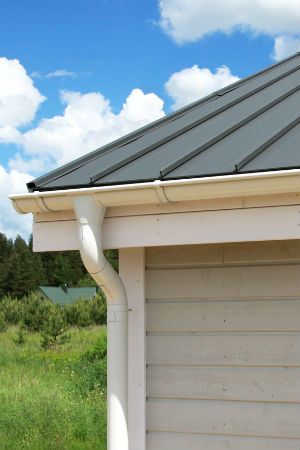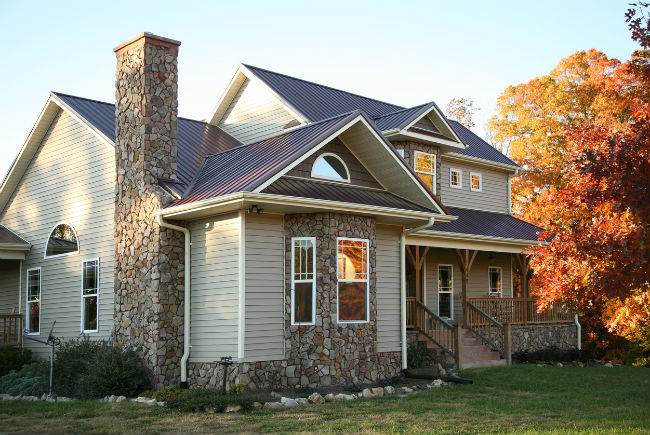We may earn revenue from the products available on this page and participate in affiliate programs. Learn More ›
Rain on a tin roof proves so soothing that it can be found on white noise machines and meditation apps alike, but that’s not the only reason (nor one of the top!) for its popularity among today’s homeowners. Growing numbers of people are installing metal roofs in both new construction and roof replacement projects. In fact, McGraw-Hill Construction and Analytics estimates that 750,000 U.S. homeowners chose metal roofing for their residences as of 2015. That number indicates an 11 percent share of the roofing market—second choice only to asphalt shingles.
Curious why this construction material has won over so many homeowners? See the complete list of metal roofing pros and cons below. Weigh them carefully, and you may find that you, too, could benefit from this reliable roofing overhead.
PRO: Metal roofs are durable and long-lasting.
At the top of the list of metal roofing “pros,” the material’s long lifespan is why most homeowners make the switch in either a re-roofing or new construction. Indeed, that recent McGraw-Hill survey found that 26 percent of homeowners cited longevity as their primary reason for investing in metal and another 22 percent said they were swayed by its strength. A properly installed metal roof typically will last as long as the house, with an expected lifespan of 40 to 70 years and, often, a 30- to 50-year manufacturer’s warranty to boot. (By contrast, traditional asphalt roofing typically lasts 12 to 20 years.) Thanks to the material’s unique durability, you can count on it to withstand the elements—including gusts of wind up to 140 miles per hour—and not corrode nor crack thanks to rust-proof coatings.
CON: Metal roofs are expensive.
The many years of service that a metal roof promises come at a high cost. This material can run from $120 to $900 per 100 square feet (or one “square” of material), according to Home Advisor’s Guide to Roofing Costs. Though this range is comparable to the costs of other premium roofing products, higher-end metals run as much as 10 times the cost of asphalt shingles. Then, not only do materials come with high price tags, but the installation labor is also more expensive than what you’d pay for other types of roofing because of the specialized training, knowledge, tools, and equipment it entails. That’s not to say that homeowners won’t recoup money on your initial investment, though. While you might have to pay for replacing a conventional asphalt shingle roof several times over the lifespan of your home, a high-quality metal roof could very likely be the last roof your home will ever need. It’s as the saying goes, “You get what you pay for.”

PRO: Metal roofs are environmentally friendly.
Traditional asphalt shingles are a petroleum product and, as such, increase dependency on fossil fuels. Plus, they require replacement every 15 to 20 years, which means that nearly 20 billion pounds of old asphalt shingles are sent to U.S. landfills every year, according to the Environmental Protection Agency.
Metal roofs, on the other hand, are considered a more sustainable alternative for a number of reasons. For starters, they consist of at least 25 percent recycled materials and are 100 percent recyclable themselves. (Steel roofing can be recycled repeatedly without loss of strength!) Metal roofing also provides an ideal platform for homeowners who want to embark various eco-conscious initiatives, including solar panels and systems for harvesting rainwater. Finally, in some re-roofing projects, a metal roof is so light—roughly one-third the weight of asphalt—that it can be installed directly overtop asphalt shingles without overburdening the roof’s structural support. This strategic move saves the effort and sheer waste of ripping off the old roofing and sending it to a landfill.
CON: Metal roofs can be dented.
Although today’s metal roofs are designed to withstand decades of abuse from extreme weather—including heavy snow and ice, both of which slide right down the slick metal slope rather than linger and cause leakage—some metal can still be dented by large hail or falling branches. Depending on the type of roof, you may not even be able to walk on the metal shingles without damaging them. If these drawbacks sound more like dealbreakers, rest assured that they can be sidestepped altogether if you choose the right shingle (preferably one that comes with a guarantee to never dent!). Some types of metal are just stronger than others. Aluminum and copper, for example, are both softer and therefore more prone to this type of damage than, say, steel.
PRO: Metal roofs are energy-efficient.
Money spent on the installation of a metal roof can be recouped from the savings in monthly cooling and heating costs thanks to this type of roof’s reflective properties. Metal roofs reflect solar radiant heat instead of absorbing it, which—yearround, but especially during the long days of summer—can reduce cooling costs by as much as 25 percent, according to the Metal Roofing Alliance. Furthermore, some metal roofing comes coated with special reflective pigments to minimize heat gain, keeping occupants comfortable without having to crank up the air conditioner.

CON: Metal roofs can be noisy.
Though listed here as a “con,” this particular drawback doesn’t need to be a given. Sure, metal could be noisier than other types of roofing, especially during a heavy rain or thunderstorm, but extra layers of solid sheathing or insulation installed beneath it will typically minimize the sound heard inside. (That said, these layers will need to be factored into the overall cost of the roof.)
PRO: Metal roofs are stylish.
Today’s metal roofs are a far cry from the corrugated tin barns of the bucolic past—indeed, now you can choose from tin, zinc, aluminum, copper, or galvanized steel, in a dizzying array of colors, finishes, and even shapes! Their variety surpasses that of the much more conventional asphalt shingle. While asphalt might offer 15 to 20 color choices, modern metal roofing comes in more than 100 different colors, including standard, premium, and custom hues. Steel and aluminum, the two most common metals used in residential roofing, are both designed to hold paint finishes well.
Seven out of 10 homeowners living under metal roofs designed theirs with the traditional vertical ribbed panels or “standing seam” construction, but metal roofing is not short on style options either. Fans of more traditional profiles can opt for a metal shingle manufactured to resemble wood shakes, slate or clay tiles, or any other number of designs instead. The metal doesn’t have to stand out like a sore thumb to do its job; rather, it can mimic nearly any look using multiple-layer factory finishes that ensure that the appearance is not only beautiful but long-lasting and durable.


